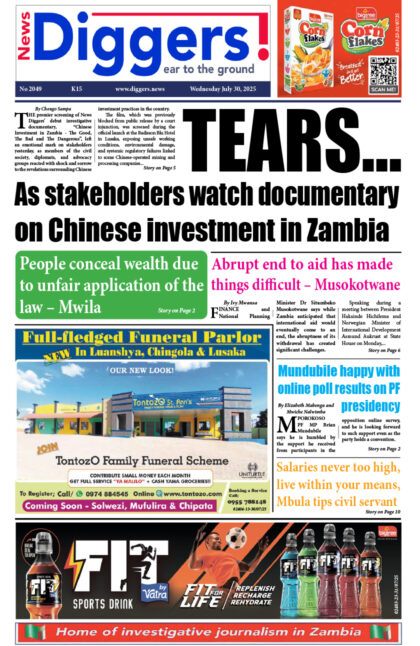Economist Chibamba Kanyama says he expects an increase in the amount of public debt reflected in the 2020 national budget given the rising number of projects that government has contracted, but without ready funds for disbursement.
President Edgar Lungu stated during his State of Nation Address that amidst austerity measures, government was implementing actions to manage the debt stock and curbing any further accumulation and save money to dismantle arrears owed to suppliers and contractors.
In an interview, Kanyama explained that the increased amount in the country’s debt stock will likely stem from unpaid government projects that had been contracted.
Zambia’s external debt stock rose to an unprecedented US $10.23 billion by June 30, 2019, from US $10.18 billion as at March 31, 2019, while domestic debt equally jumped to K60.3 billion compared to K58.3 billion during the same corresponding period.
“It is for this reason that the International Monetary Fund and other bona fide creditors have advised that government slows down on the acquisition of debt. The question is: is there a possibility the budget will not reflect any new debt? I foresee a situation where debts will continue to rise, albeit slower than before, because some projects have already been contracted except funds are not dispersed. Some of the projects that had only mobilised to commence execution will not easily be cancelled without paying a premium,” Kanyama said.
He said as Zambia drew closer to the 2021 general election, it remained unrealistic for government to halt projects in certain areas.
“In terms of cost benefit, government may actually find it cheaper to allow some projects to continue to the end than cancel them because whether or not we execute, contractors will demand payment with interest! We are also going towards an election year and it will be unrealistic for government to halt projects in certain areas of the country when work has already started. I foresee a situation where some projects may continue, but financial accounting staggered so that the figures do not dilute debt sustainability,” he added.
Kanyama said government’s decision to use funds from debt on infrastructural development was a challenge as there was no guarantee that the investment inflows would give reasonable pay back.
“You may wish to know, the primary reason we are at the verge of debt distress is because of government’s infrastructural roll out. First of all, borrowing for purposes of investment projects is a good thing. This is even more critical for Zambia that has for many several decades been starved of this kind of new infrastructural investment done in a very short period of time,” Kanyama said.
“If we have to be competitive as a country and attract the much-needed domestic and foreign investment, we have to invest in solid road networks and such should be across all potential economic zones around the country. The challenge, though, for us is whether or not the projection of investment inflows will give us a reasonable pay back. The loans are not free, we are paying back with interest over a period of time.”
He pointed out that the cost of road construction would make it difficult to foster payback.
“The lead time for payback is usually below 20 years and I am not sure whether the roads currently under construction will survive this gestation period before they are overhauled. Another issue is the cost of construction as others have argued the pricing is too exorbitant to slow for a payback,” he observed.
“Payback for infrastructure investment is not only indirect via private investment inflows; payback is also through road tolls. Those who have worked out the net present value for the US $1.2 billion Lusaka-Ndola dual carriageway argue that it will require trebling the current toll fees for a realistic payback in 25-30 years.”
Kanyama noted that the use of international companies in the construction sector had also made it difficult to control the accumulating debt.
“Another challenge is that the trickle-down effect on infrastructural investment is critically low because the construction companies are not local, neither do they have reasonable local content. Infrastructural investment has its short-term impact when borrowed funds are, generally, from the local market and a good portion of construction activity and resourcing is domestic,” he observed.
And he said that the fiscal deficit was likely to continuing widening next year in view of the mismatch between expenditure and revenues.
“Another challenge I foresee in 2020 is the widening fiscal deficit and low international reserves. Government definitely needs balance of payments of support to improve its international (credit) ratings and be in a position to attract fresh money. What we need, now, are concessional loans,” he said.
“There are bilateral and multilateral creditors, who are willing to support Zambia any time provided certain benchmarks are met – one being an IMF (International Monetary Fund) programme. The Minister (Dr Ng’andu) is keeping his mind on this issue for sure because, having been at the Bank of Zambia, he understands the dynamics around balance of payments.”
Kanyama further said though domestic borrowing by government was healthy for the economy, it was important for government not to compete with the private sector.
“Domestic borrowings are healthy for the economy provided it does not fall into arrears and there is a capping to it, usually not more than 3 per cent of GDP. This allows the economy to continue actively because government spending is in itself a crucial ingredient in pulling out a stagnant economy from stalling. However, just as much as this is essential, there is a limit to which government can compete with the private sector, more so now that liquidity is very low in the economy,” said Kanyama.



















